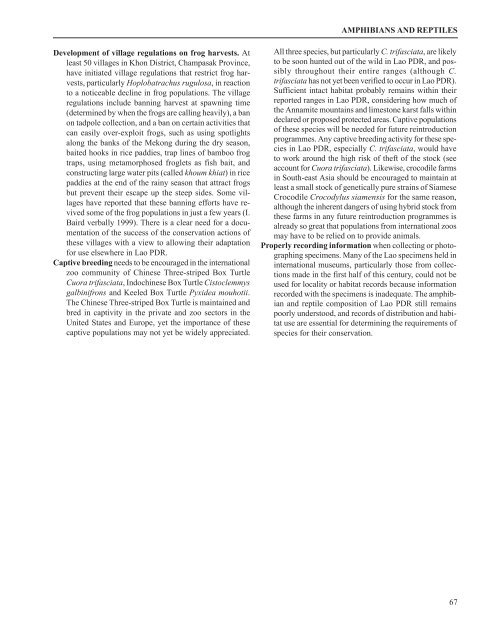Wildlife of Lao PDR: 1999 Status Report - IUCN
Wildlife of Lao PDR: 1999 Status Report - IUCN
Wildlife of Lao PDR: 1999 Status Report - IUCN
Create successful ePaper yourself
Turn your PDF publications into a flip-book with our unique Google optimized e-Paper software.
Development <strong>of</strong> village regulations on frog harvests. At<br />
least 50 villages in Khon District, Champasak Province,<br />
have initiated village regulations that restrict frog harvests,<br />
particularly Hoplobatrachus rugulosa, in reaction<br />
to a noticeable decline in frog populations. The village<br />
regulations include banning harvest at spawning time<br />
(determined by when the frogs are calling heavily), a ban<br />
on tadpole collection, and a ban on certain activities that<br />
can easily over-exploit frogs, such as using spotlights<br />
along the banks <strong>of</strong> the Mekong during the dry season,<br />
baited hooks in rice paddies, trap lines <strong>of</strong> bamboo frog<br />
traps, using metamorphosed froglets as fish bait, and<br />
constructing large water pits (called khoum khiat) in rice<br />
paddies at the end <strong>of</strong> the rainy season that attract frogs<br />
but prevent their escape up the steep sides. Some villages<br />
have reported that these banning efforts have revived<br />
some <strong>of</strong> the frog populations in just a few years (I.<br />
Baird verbally <strong>1999</strong>). There is a clear need for a documentation<br />
<strong>of</strong> the success <strong>of</strong> the conservation actions <strong>of</strong><br />
these villages with a view to allowing their adaptation<br />
for use elsewhere in <strong>Lao</strong> <strong>PDR</strong>.<br />
Captive breeding needs to be encouraged in the international<br />
zoo community <strong>of</strong> Chinese Three-striped Box Turtle<br />
Cuora trifasciata, Indochinese Box Turtle Cistoclemmys<br />
galbinifrons and Keeled Box Turtle Pyxidea mouhotii.<br />
The Chinese Three-striped Box Turtle is maintained and<br />
bred in captivity in the private and zoo sectors in the<br />
United States and Europe, yet the importance <strong>of</strong> these<br />
captive populations may not yet be widely appreciated.<br />
AMPHIBIANS AND REPTILES<br />
All three species, but particularly C. trifasciata, are likely<br />
to be soon hunted out <strong>of</strong> the wild in <strong>Lao</strong> <strong>PDR</strong>, and possibly<br />
throughout their entire ranges (although C.<br />
trifasciata has not yet been verified to occur in <strong>Lao</strong> <strong>PDR</strong>).<br />
Sufficient intact habitat probably remains within their<br />
reported ranges in <strong>Lao</strong> <strong>PDR</strong>, considering how much <strong>of</strong><br />
the Annamite mountains and limestone karst falls within<br />
declared or proposed protected areas. Captive populations<br />
<strong>of</strong> these species will be needed for future reintroduction<br />
programmes. Any captive breeding activity for these species<br />
in <strong>Lao</strong> <strong>PDR</strong>, especially C. trifasciata, would have<br />
to work around the high risk <strong>of</strong> theft <strong>of</strong> the stock (see<br />
account for Cuora trifasciata). Likewise, crocodile farms<br />
in South-east Asia should be encouraged to maintain at<br />
least a small stock <strong>of</strong> genetically pure strains <strong>of</strong> Siamese<br />
Crocodile Crocodylus siamensis for the same reason,<br />
although the inherent dangers <strong>of</strong> using hybrid stock from<br />
these farms in any future reintroduction programmes is<br />
already so great that populations from international zoos<br />
may have to be relied on to provide animals.<br />
Properly recording information when collecting or photographing<br />
specimens. Many <strong>of</strong> the <strong>Lao</strong> specimens held in<br />
international museums, particularly those from collections<br />
made in the first half <strong>of</strong> this century, could not be<br />
used for locality or habitat records because information<br />
recorded with the specimens is inadequate. The amphibian<br />
and reptile composition <strong>of</strong> <strong>Lao</strong> <strong>PDR</strong> still remains<br />
poorly understood, and records <strong>of</strong> distribution and habitat<br />
use are essential for determining the requirements <strong>of</strong><br />
species for their conservation.<br />
67

















